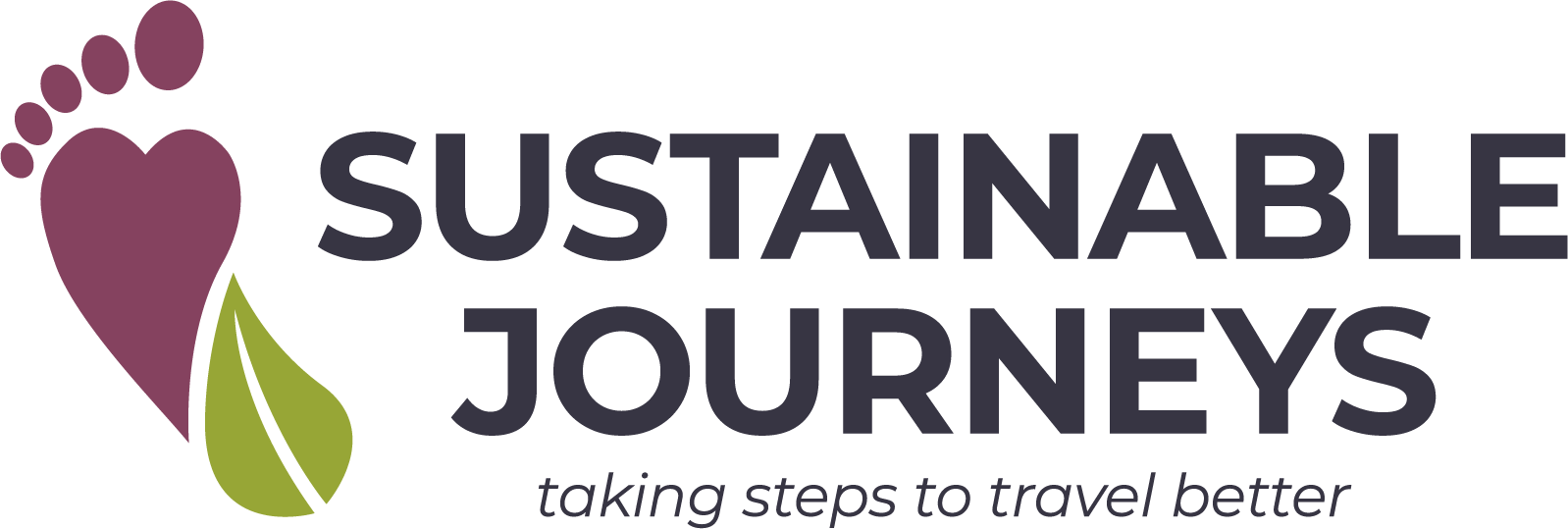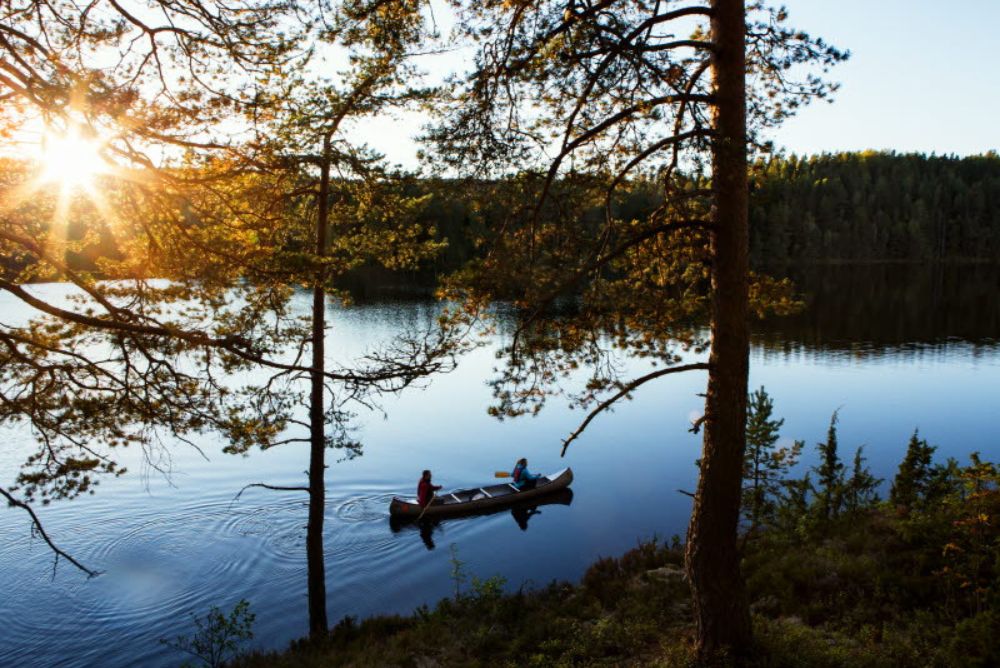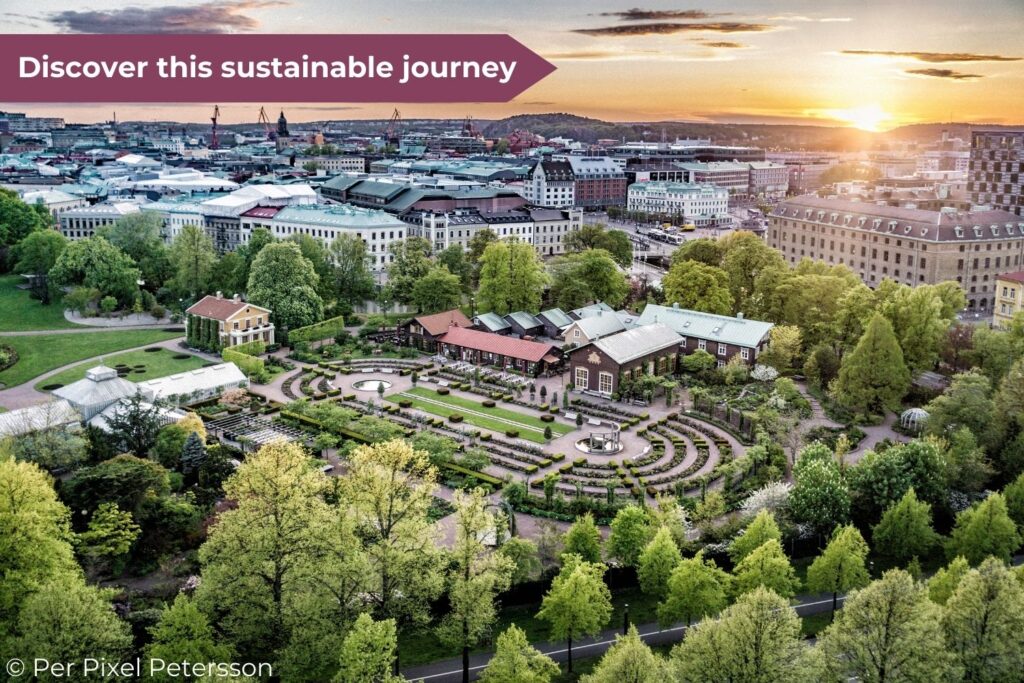By Sarah Baxter
The first rays of sunshine peeped over the eastern horizon, sneaking between the trees and through the cabin’s antique windowpanes. I was cosy inside, but couldn’t resist the call of the honeyed light. I slipped out from under the duvet and moss-green sheepskins, and pulled on my swimmers. I grabbed a robe, opened the aged wooden doors and headed outside.
It was cool, but not cold, the ground dew-damp and stippled with fallen acorns. I walked via the vegetable patch, down to the lake edge, where wild strawberries grow in summer and a jetty extended from the rocks. I looked past the reeds to the islands. The tiny one was known as Snake Island, I’d been told. I wouldn’t swim there… The larger was home to a shipyard in the 18th and 19th centuries; it built freighters that sailed through this saturated land, out to foreign shores. It was impossible to imagine how busy with bustle and trade these now-silent waterways had once been.
Fascinating. But I was procrastinating. Finally, I dropped the robe, walked the jetty and plunged into the crisp, still blue.

I’m not sure there are many finer places to wake up than at Swedish Country Living. Created by David and Marie Naraine, at their 19th-century summerhouse in lake-speckled Dalsland province, it’s a paragon of stylish sustainability. It’s also a distillation of all that’s excellent about West Sweden, a region with a firm focus on making tourism as low-impact and high-benefit as possible. I was on a grand green tour, staying at some remarkable climate-smart retreats, aiming to leave the lightest of carbon footprints while fully soaking up the nature, culture and stories that make it unique.
Swedish Country Living ticked all the boxes. David and Marie used to work in restaurants and designer fashion but traded in city life for a rural smallholding, on which they’ve built a handful of utterly gorgeous and truly sustainable cabins. It is a place to live off-grid, in the loveliest way.
Ready for your own EV adventure in West Sweden? Spend 12-days exploring Gothenburg, Skaftö, and Kållandsö with an electric car. Stay in unique properties and experience the tranquil southern islands of the Gothenburg archipelago, the historical site of Baldersnäs Manor, and the lush Naturum Vänerskärgården nature reserve.

I was sleeping in the Slate House, a tiny hermitage built from salvaged doors and windows, wood felled on site and recycled slate tiles. It had no electricity, though there were candles everywhere, a wood-burning stove, Turkish rugs and hemp insulation under the floorboards, which, David told me, also keeps mice out.
It had no running water or ensuite either, but I had access to my own private room in the shower block. Its walls were made of clay, sand and straw, which buffers moisture. Inside was a separating toilet: diluted urine is spread on the apple trees; faeces is broken down and the compost returned to the soil. My shower was fed by lake water which, once used, was filtered via the plants in the greenhouse then pumped, clean, back into the lake. This kind of system is key to sustainability, David said: “When you stay in a place that’s so-called ‘sustainable’, always ask how circular they are.”

I relished my time here. I took a canoe out on the lake, listening for loons. I cooked my own pizza in the outdoor kitchen. And I drank a chill glass of homemade sparkling meadowsweet as I luxuriated in the outdoor spa, a wood-fired tub sunk down on the shore so no one can see you over the reeds.

But, as tempting as it was to go nowhere, I did venture further afield. Passing within a whisker of Swedish Country Living is the Pilgrimsleden. This 100km trail through Dalsland follows the route medieval pilgrims took to the tomb of St Olaf in Nidaros (now Trondheim). I walked a bit of it, from nearby Svankila Nature Reserve to the village of Upperud. It was a wide, easy track, flanked by mushroomy forest and the sorts of wooden waterside summerhouses, painted traditional falu red, that make you want to up sticks and move in. A herd of cows lowed loudly as I passed, and critters unseen rustled in the undergrowth, but otherwise all was quiet.
Upperud itself was quiet too. I had the lovely Art Museum to myself, and slowly browsed the small but fascinating collection, including works by local-born Otto Hesselbom (1848-1913), master of capturing this landscape’s dark mystery. I ate my picnic lunch – a spicy salad in a reusable glass jar, prepared by David – at a table overlooking the tree-frilled islets of Lake Spången.

There are two locks in Upperud, part of the ambitious Dalsland Canal system. This grand feat of engineering, completed in 1868, allowed boats to sail between Lake Vänern and the world beyond – a boon for the region’s ironworks, which previously had to lug their ore overland to Gothenburg. Only 12km of the canal’s 240km length is actually dug, the rest uses the region’s abundance of navigable lakes and waterways – there are more lakes in Dalasland than any other part of Sweden.
However, the biggest challenge was faced at nearby Håverud, a couple of kilometres further north, where engineers had to somehow navigate a soft, steep gully and the rapids of the Håfre River. The solution was the Håverud aqueduct, now one of the region’s most popular sites. In summer people flock here to visit the Canal Museum and watch small boats and kayaks pass through. However, on a sunny September day, it was crowd-free, and I strolled unhindered, below the road and rail bridges that also cross here, and along the unique aqueduct, which dangles daringly over the river below.

As the canal leads east to Vänern, Sweden’s largest lake, so did I, keen to explore the province of Västergötland, a land of forests, farmland, ancient plateaus, and more history-rich hiking trails. I was particularly fascinated by the 140km-long Biosphere Trail, opened in 2022, which skirts Vänern’s south shore between the old town of Mariestad and baroque Läckö Castle. This new footpath appealed because of the terrain it opens up, from little fishing ports to Sweden’s first UNESCO Global Geopark. It also appealed as it’s accessible by train. The picturesque little Kinnekullebanan interweaves with the trail and provides an easy, green and fun way for hikers to reach the route.
I did just that, meeting guide Amanda Hessle at Hällekis, a station so tiny it’s a request stop. Amanda showed me what to do: turn the tall metal paddle on the platform, to alert the train driver that you want to get on. We then rode the line to even tinier Råbäck station, hopping out to walk the 10km or so back via the slopes of Kinnekulle, a flat-topped mountain whose rocks tell a story spanning 540 million years.
Almost immediately we entered the nature reserve of Munkängarna (Monks’ Meadows), an atmospheric grove of oak, elm and ash, where the first autumn leaves crunched underfoot as we walked. We soon emerged at Stora Stenbrottet – Sweden’s ‘Grand Canyon’ – where centuries of quarrying have laid bare striking strata of ancient rock. There’s no industry here these days, just birds enjoying the water-filled cleft, and some climbers scaling the sides.

From here, we carried on, down a stone staircase built for the king in 1772, via the grand grounds of Hellekis Manor and through Hellekis nature reserve to Vänern’s shores, keeping an eye out for fish eagles. We inhaled the freshness of the lakeside forest, strolled a sandy beach and drank our thermos of coffee on a rock ledge with a perfect view. It was an idyllic mini-adventure.
But, I’d discovered, West Sweden is full of such things. Simple, sustainable pleasures – from wild sunrise dips to walks through deep time – that take you off grid but plug you right into nature.
Feeling inspired? Experience the magic for yourself by booking one of our Sustainable Journeys.
Editorial submission – 14th December 2023









